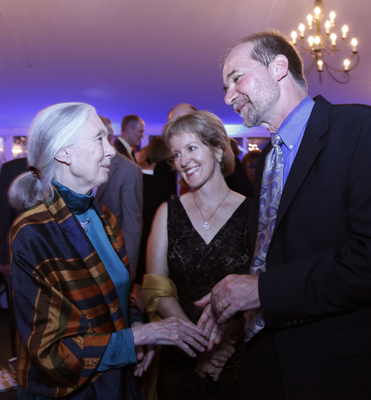
By Dr. Richard Beilfuss, ICF President & CEO
This update is reprinted from the November 2013 issue of The ICF Bugle
Wow, what a time we had! From Heather Henson’s thrilling Celebration of Flight, to Dr. Jane Goodall’s inspiring words for the conservation leaders of tomorrow, our 40th Anniversary Gala stirred the heart (view our photo album from the September weekend). Whether you joined us in Milwaukee, or in spirit, each of you – our sponsors, members, supporters, and partners – made possible the wonderful achievements we honored.
At its heart, our Gala was a celebration of the ICF dream – that we join together over our shared passion for cranes, and together make a real difference for cranes, for the earth, and for ourselves. Like many of our ICF staff and colleagues worldwide, I have participated for much of my life in this dream, which has taken me to crane lands in 30 countries across five continents. Everywhere I have worked and visited, I have marveled how deeply cranes are embedded in the tapestry of human history and culture. This deep connection is a wellspring of seemingly inexhaustible passion to save cranes and the landscapes we share with them.
I first experienced the ICF dream in the 1980s, when we were searching for conservation solutions for vanishing Eastern Sarus Cranes and wetlands in the rapidly developing Mekong Delta of Vietnam. We asked many villagers about their Seu Dau Do (literally “red-headed cranes”), but received little more than shrugs. Then one day, we discovered that local people have a second, preferred name for the Sarus Crane, Học, which means, “the holy bird that takes your soul to heaven.” When we asked local people about the Học, we learned that villagers knew much about these birds, and cared deeply about them. Their reverence for cranes, and commitment to save them with our help, led to the creation of Tram Chim National Park, securing one of the most diverse and productive wetlands in Southeast Asia.
In Uganda – where the Endangered Grey Crowned Crane adorns the national flag, the Coat of Arms, and the National “Crane” Bank – and neighboring Kenya our dream also thrives. Over the years, thousands of enthusiastic school kids have joined together in after-school clubs to save cranes and wetlands, under the inspired leadership of ICF Associates Jimmy Muheebwa and Maurice Wanjala. They rejoiced in their cranes through drumming, dance, and songs, while guarding crane nests from people, tractors, and dogs. They are champions for the small wetlands that support cranes and provide many important services to their communities.
In some of the most important river basins in the world, our dream is alive among unexpected allies – dam operators, municipal governments, artisanal fishers, prawn companies, riverbank farmers, safari operators, village councils. From the Amur to the Zambezi, the future of cranes depends on healthy watersheds and thriving communities.
Over the next 40 years, we hope our dream will include important new chapters in the story of people and cranes. A reunified Korea will decide whether the former Demilitarized Zone becomes an international Peace Park and biosphere reserve for its immeasurable wealth of wildlife – including Endangered Red Crowned Cranes – or gives way to a progression of roads, ports, and cities. Chinese officials will commit to saving Poyang Lake, the most important wetland in East Asia for waterbirds and home to the entire wintering population of Critically Endangered Siberian Cranes, or dam and regulate it for commerce. Texas will find sustainable solutions for managing its land and waters, or witness the loss of the last remaining wild flock of Endangered Whooping Cranes and the coastal way of life. With your support, our work together will make a profound difference for the future of Korea, China, Texas, and everywhere we work. Thank you for sharing in our dream.
